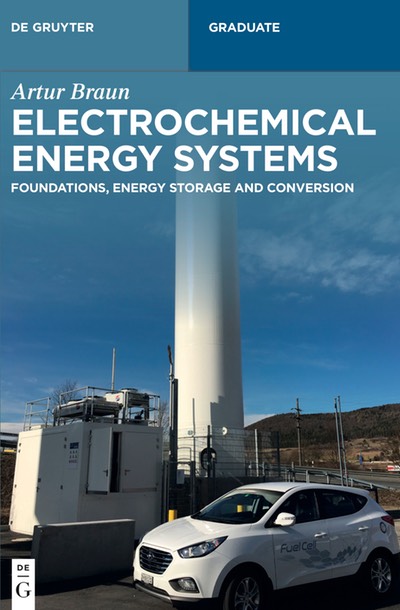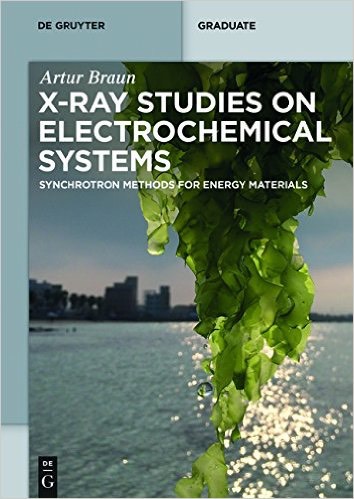Air pollution and climate change are topics of great public interest (you can download at the bottom my posters or pre-preprints, or have a look at Paul Alivisatos' recent Bethe Lecture at Cornell University in Fall 2011 on the Carbon Cycle, http://www.cornell.edu/video/?videoID=1764 ). From 2001-2005 I worked at the University of Kentucky in Lexington on airborne carbonaceous particulate matter (PM). I was funded by U.S. National Science Foundation with the Grant for "Molecular Structure and Microstructure of PM2.5 Derived from Stationary and Mobile Fossil Fuel Sources". Here I could develop C1s NEXAFS spectroscopy as a novel tool for the molecular characterization and speciation of PM-NEXAFS (Near-Edge X-ray Absorption Fine Structure) is a synchrotron based x-ray spectroscopy method that permits to analyze chemical moeities at the molecular level. We were actually the first group to apply scanning transmission x-ray microspectroscopy (STXM) on diesel soot, see reference below [1].
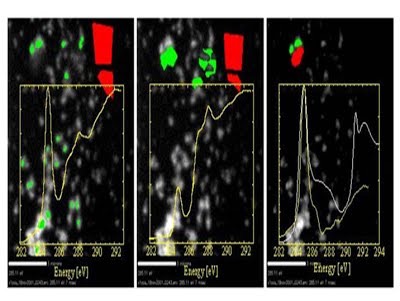
Figure: STXM images of diesel particulate matter at 285.11 eV (sensitive to C=C bonds) of DEP (bright spots) after one drop of added acetone was evaporated, causing extraction of solubles. Green areas are summed up for I(E), red areas are summed up for Io(E). Spectrum on the left is indicative of DEP. Spectrum in the center is representative of an acetone-soluble organic matter. Spectrum on the right is the difference of both spectra, highlighting the semigraphitic characteristics of the DEP. The white spectrum is from graphite.
During my time with the Consortium for Fossil Fuel Sciences in Lexington in Kentucky I worked on fuel combustion products and their carbon specific molecular assessment using synchrotron x-ray analytical techniques such as NEXAFS spectroscopy, and wide and small angle x-ray scattering (WAXS, and SAXS). My first synchrotron experiments in this repsect were done at the STXM Beamline X1A at the NSLS in Brookhaven (see middle below). I did a few USAXS studies on soot at UNICAT and BESSRC-CAT at the APS (see right below), and most NEXAFS studies were done at the ALS (see left below).
Below on the left you can see a set of carbon NEXAFS spectra from diesel exhaust particulates (DEP) - basically diesel soot that you can collect from the exhaust tube of a diesel car - which were weathered on my balcony for a couple of weeks during winter 2008. The spectra show peaks, x-ray absorption resonances which are characteristic for particular molecular motifs. Upon close inspection of all spectra we notice systematic differences upon "weathering" on the balcony outside of my apartment. On the right you see analyzed NEXAFS data extracted from the spectra on the left. So, basically. DEP was subject to weathering by exposure to ambient atmosphere (air, humidity, solar radiation, and temperature variation) for seven weeks and shows systematic changes in C(1s) x-ray absorption spectra, depending on how long the DEP was exposed. Quantitative analysis suggests that volatile polycyclic aromatic hydrocarbons are released from the DEP by desorption, paralleled or followed by decomposition and reaction of the amorphous part of the solid, non-volatile carbon and potential other volatile species. The observed spectral changes are rationalized in a simple two phase model combining desorption of volatiles and oxidation of carbon matrix is presented. The weathering characteristic of soot is generalized toward biomass burning products and identified as a vector quantity to be implemented for climate modeling.
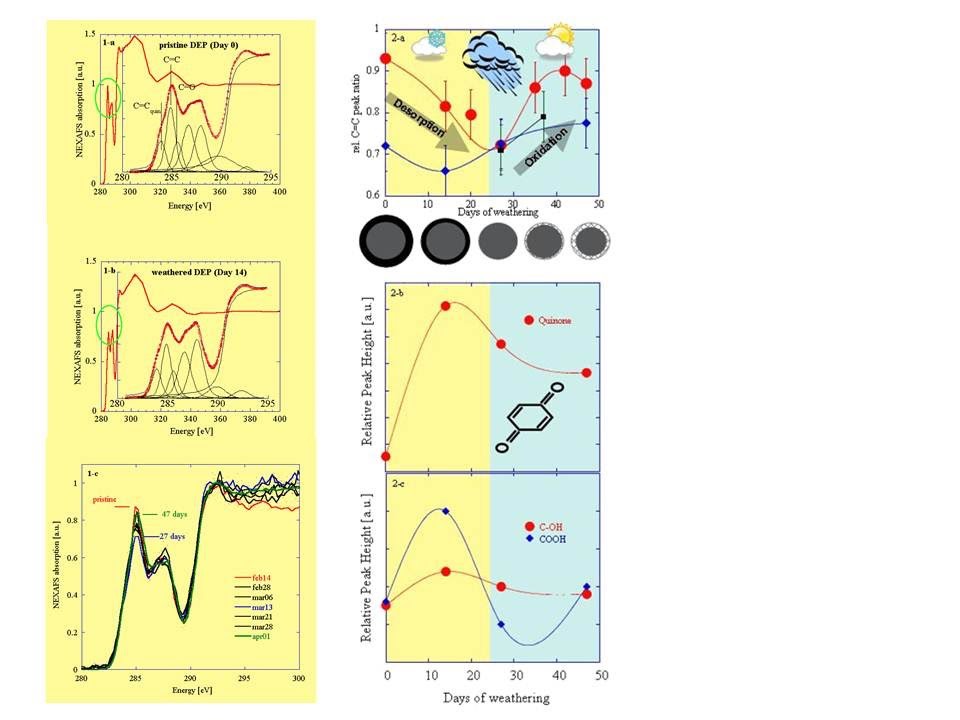
Climate change and air pollution: Who takes the blame ? Therefore, source attribution is a major task in the investigation of air pollution. When air is sampled in cities, roads, rural areas or in air space, the collected specimen may contain a whole variety of moeities and it is very difficult to state what particular source contributed to which extent to the sampled specimen. This holds also for carbonaceous particulate matter, which may be generated from gasoline vehicles, diesel vehivles, domestic wood combustion, coal power plants, wildfires, and so on. However, PM samples from these sources may contain specific signatures that can to some extent be resolved with NEXAFS spectroscopy.
We started with soot from diesel engines and found that different diesel fuels, different engine operation conditions or fuel additives changed the molecular structure and thus the spectroscopic signatures of the resulting soot, as was evident from the resulting NEXAFS spectra. We then looked at exhaust particles from gasoline vehicles, jet engines, and later even investigated a whole range of biomass derived or wood smoke samples. Below you see a graphics where the relative NEXAFS peak heights from aromatic motifs and hydroxyl groups in various wood smoke samples are plotted versus the dry time of the wood. We learnt more and more about the combustion characteristics of these "fuels" and how their residuals showed up in specimen obtained by ambient sampling in cities. In the end we arrived at a stage where we could at least semi-quantitatively say to what extent ambient PM samples derived from which type of fuels.
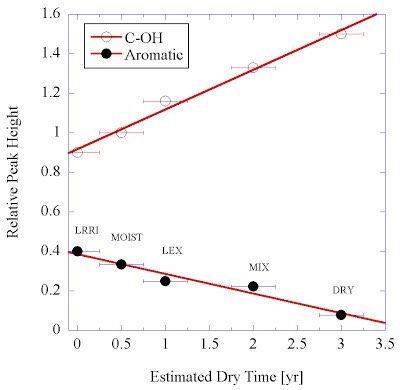
FIGURE:. Relative NEXAFS peak heights of the C-OH peak at 287 eV and the aromatic C=C peak at 285 eV for WS samples as a function of estimated drying time of wood.
The next graph below shows a linear combination of spectra from wood smoke (WS MOIST) and diesel soot (DEP FTP-75). We can state that the PM samples from St. Louis and Lexington are likely not dominated by DEP characteristic signatures, particularly when we allow for the effect of changes in DEP spectra upon weathering. Instead, structures that are typical to wood smoke can be clearly identified.
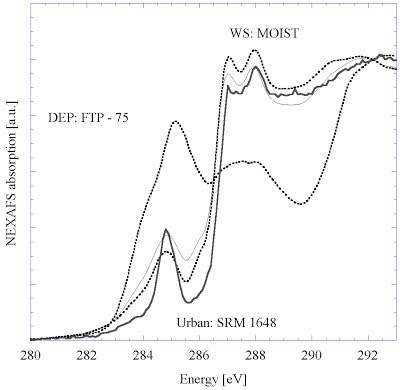
FIGURE . Spectra of DEP FTP-75 (sampled at day 10), WS MOIST, and SRM 1648 (all thick lines). The thin line spectrum is a linear combination with 10% DEP and 90% WS spectrum.
Publications on C(1s) NEXAFS, STXM, SAXS, WAXS on carbonaceous aerosols
18. A.I. Totlandsdal, J.I. Herseth, A. Kocbach Bølling, A. Kubátová, A. Braun, R. E. Cochran, M. Refsnes, J. Øvrevik, M. Låg , Differential effects of the particle core and organic extract of diesel exhaust particles, accepted by Toxicology Letters. http://www.sciencedirect.com/science/article/pii/S0378427411016018
17. A Braun, Comment on “Effects of Native Organic Material and Water on Sorption Properties of Reference Diesel Soot”, Environmental Science & Technology, 2009, 43 (13), 5158–5159. http://pubs.acs.org/doi/pdf/10.1021/es900943r
16. A Braun, Two-process model for the atmospheric weathering, oxidation and ageing of diesel soot, Geophysical Research Letters 2009, 36, L07810. http://www.agu.org/pubs/crossref/2009/2008GL037077.shtml
15. A Kubatova, T. J. Lahren, J. Beranek, I. P. Smoliakova, A. Braun, and F. E. Huggins, Extractable Organic Carbon and its Differentiation by Polarity in Diesel Exhaust, Wood Smoke and Urban Particulate Matter, Aerosol Science and Technology, 43:714–729, 2009. http://www.informaworld.com/smpp/content~content=a910673385~db=all~jumptype=rss
14. A. Braun, F.E. Huggins, A. Kubátová , S. Wirick, B.S. Mun, J.M.D. Mcdonald, M.M. Maricq, K.E. Kelly, N. Shah, G.P. Huffman; Towards distinguishing wood-smoke and diesel exhaust in ambient particulate matter. Environmental Science & Technology 2008, 42(2) 374-380. http://pubs.acs.org/doi/abs/10.1021/es071260k
13. Braun, A. Kubatova, S. Wirick, S.B. Mun. Radiation damage from EELS and NEXAFS in diesel soot and diesel soot extracts. Spec. Issue on Radiation Damage in J. Electron Spectroscopy & Related Phenomena, 170, (1/3), 2009, 42-48. http://www.sciencedirect.com/science/article/B6TGC-4PDSBJX-1/2/cb4ddfd0a33a045aaa070ff1cba6a189
12. A Braun, BS Mun, FE Huggins, GP Huffman. Carbon speciation of diesel exhaust and urban particulate matter NIST standard reference materials with C(1s) NEXAFS spectroscopy, Environmental Science & Technology 2007, 41, 173-178. http://pubs.acs.org/doi/abs/10.1021/es061044w
11. A Braun, Some comments on "Soot surface area evolution during air oxidation as evaluated by small angle X-ray scattering and CO2 adsorption”. Carbon 2006, 44/7, 1313-1315 (Letter to the Editor). http://www.sciencedirect.com/science/article/B6TWD-4J90W63-3/2/49c56b6fbef1f5a50f23ef289a45879c
10. A Braun, N. Shah, F.E. Huggins, G.P. Huffman, K.E. Kelly, S.B. Mun, S.N. Ehrlich, Impact of ferrocene on the structure of diesel exhaust soot as probed with wide-angle X-ray scattering and C(1s) NEXAFS spectroscopy, Carbon (2006) 44/14 2904-2911. http://www.science-direct.com/science/article/B6TWD-4KF1HTM-4/2/c5e0b859abbdbd393cca31ac116c4a87
9. A. Braun, S. Wirick, A. Kubátová, B.S. Mun, F.E. Huggins, Photochemically induced decarboxylation in diesel soot extracts. Atmospheric Environment 40(30) 2006, 5837-5844. http://www.science-direct.com/science/article/B6VH3-4KBVX33-6/2/e13564b01a9284a8bfada97a702f925f
8. S di Stasio, A Braun. Comparative NEXAFS Study on soot obtained from an ethylene/air flame, a diesel engine, and graphite. Energy & Fuels 2006, 20(1), 187-194. http://pubs.acs.org/doi/abs/10.1021/ef058019g
7. Y Chen, N Shah, A Braun, FE Huggins, GP Huffman, Electron microscopy investigation of carbonaceous particulate matter generated by combustion of fossil fuels, Energy & Fuels 2005 19, 1644-1651. http://pubs.acs.org/doi/abs/10.1021/ef049736y
6. A Braun, N Shah, FE Huggins, KE Kelly, A Sarofim, C Jacobsen, S Wirick, H Francis, J Ilavsky, GE Thomas and GP Huffman. X-ray scattering and spectroscopy studies on diesel soot from oxygenated fuel under various engine load conditions, Carbon 43, (12), 2588-2599 (2005). http://www.sciencedirect.com/science/article/B6TWD-4GKWJ45-1/2/031b39bcf380c13f3f495a48d1f3fe7d
5. A Braun, Carbon speciation in airborne particulate matter with C (1s) NEXAFS spectroscopy, J. Env. Monitoring, 2005, 7(11), 1059-1065. (invited critical review)
http://www.rsc.org/publishing/journals/EM/article.asp?doi=b508910g
4. A Braun, J Ilavsky, S Seifert, PR Jemian. Deformation of diesel soot aggregates as a function of pellet pressure: A study with ultra-small-angle x-ray scattering. Journal of Applied Physics 98, 073513 (2005) http://dx.doi.org/ DOI:10.1063/1.2071456
3. A Braun, S Wirick, C Jacobsen, F Huggins, S Mun, N Shah, Y Chen, G Huffman, Advantages of soft X-ray absorption over TEM-EELS for solid carbon studies - a comparative study on diesel soot with EELS and NEXAFS. Carbon 43 (2005) 117-124. http://www.science-direct.com/science/article/B6TWD-4DJBNCG-4/2/0509b0188cb75664788aa4e61b4e40da
2. A Braun, FE Huggins, S Seifert, J Ilavsky, N Shah, K Kelly, A Sarofim, GP Huffman. Size-range analysis of diesel soot powders and pellets with ultra small angle X-ray scattering. Combustion & Flame 137 (1/2) pp. 63-72 (2004). http://www.sciencedirect.com/science/article/B6V2B-4BNMCFR-2/2/fc9a788f2030c9e26f3af214e65698e8
1. A Braun, N Shah, FE Huggins, C Jacobsen, S Wirick, K Kelly, A Sarofim, GP Huffman. A study of diesel PM with X-ray microspectroscopy. Fuel (2004) 83, 7/8, 997-1000. http://www.sciencedirect.com/science/article/B6V3B-49SFDT3-2/2/601af1908199a286339c369de2c2b6f9

